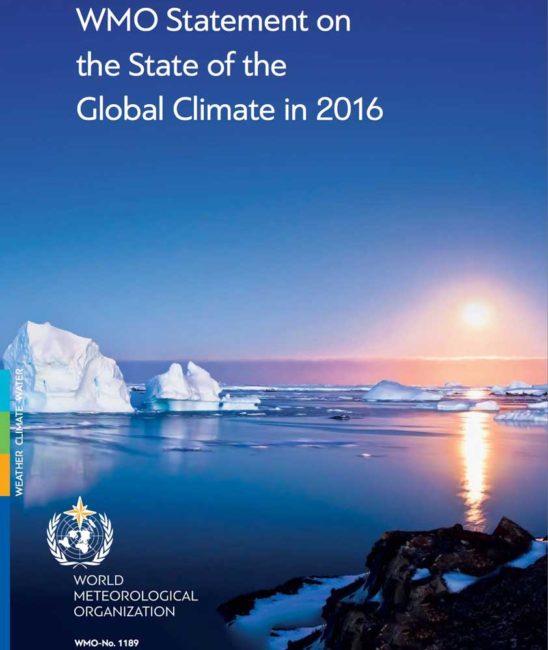Today, 23rd March, is World Meteorological Day. To mark the occasion the World Meteorological Organisation has issued an official statement regarding the state of the climate during 2016.
It is not good.
The content is not an option, nor a belief, or “conspiracy” by one specific organisation. Instead it is an evidence based statement that is firmly backed up by the multiple international datasets maintained independently by global climate analysis centres and information submitted by dozens of WMO Members, National Meteorological, and Hydrological Services and Research Institutes, and is an authoritative source of reference.
Key Findings
The following sums up the key findings within the WMO statement …
Global Temperatures:
2016’s warmth extended almost worldwide. Temperatures were above the 1961-90 average over the vast majority of the world’s land areas, the only significant exceptions being an area of South America centred on central Argentina, and parts of south-western Australia.
Mean annual temperatures at least 3 °C above the 1961-1990 average occurred in various high-latitude locations, particularly along the Russian coast and in Alaska and far north-western Canada, and on islands in the Barents and Norwegian Seas. In the high Arctic, Svalbard (Norway) Airport’s 2016 mean annual temperature of −0.1 °C was 6.5 °C above the 1961-1990 average, and 1.6 °C above the previous record.
Outside the Arctic, 2016’s warmth was more notable for its consistency across the globe than for its extreme nature in individual locations.
Oceans
Globally averaged sea surface temperatures in 2016 were the warmest on record. The anomalies were strongest in the early months of 2016.
Global ocean heat content was the second-highest on record after 2015. It reached new record highs in the northern hemisphere, but was cooler in the southern hemisphere.
Globally, sea level has risen by 20 cm since the start of the twentieth century, mostly due to thermal expansion of the oceans and melting of glaciers and ice caps. Global sea levels rose very strongly during the 2015/2016 El Niño, rising about 15 millimetres between November 2014 to a new record high in February 2016. This was well above the post-1993 trend of 3 to 3.5 mm per year. From February to August, sea levels remained fairly stable as the influence of the El Niño declined. Final 2016 sea level data are not yet available at the time of writing.
Arctic sea ice
The seasonal maximum, of 14.52 million square kilometres on 24 March, was the lowest in the 1979-2016 satellite record. The 2016 autumn freeze-up was exceptionally slow – with sea ice extent even contracting for a few days in mid-November.
Precipitation
Much of southern Africa began the year in severe drought. For the second year in succession, rainfall was widely 20 to 60% below average for the summer rainy season (October to April) in 2015/2016. The World Food Programme estimating that 18.2 million people would require emergency assistance by early 2017.
Provisional figures showed 2016 was the driest on record over the Amazon Basin, and there was also significant drought in north-east Brazil. El Niño brought drought conditions elsewhere in Central America and northern South America.
The Yangtze basin in China experienced, overall, its most significant flood season since 1999, with some tributaries experiencing record flood levels. Averaged over China as a whole, it was the wettest year on record, with national mean rainfall of 730 mm being 16% above the long-term average.
Heatwaves
The year started with an extreme heatwave in southern Africa in the first week of January. On 7 January, it reached 42.7 °C at Pretoria and 38.9 °C at Johannesburg, both of which were 3 °C or more above the all-time records at those sites.
Extreme heat also affected South and South-East Asia in April and May, prior to the start of the summer monsoon. South-East Asia was badly affected in April. A national record of 44.6 °C was set at Mae Hong Son, Thailand, on 28 April, and 51.0 °C was observed on 19 May at Phalodi, the highest temperature on record for India.
Record or near-record temperatures occurred in parts of the Middle East and north Africa. The highest temperature observed was 54.0 °C at Mitribah (Kuwait) on 21 July which (subject to ratification) will be the highest temperature on record for Asia. Other extremely high temperatures included 53.9 °C at Basra (Iraq) and 53.0 °C at Delhoran (Islamic Republic of Iran – a national record), both on 22 July, whilst significant high temperatures were also reported in Morocco, Tunisia, Libya and the United Arab Emirates.
A late-season heatwave affected many parts of western and central Europe in the first half of September. In southern Spain, 45.4 °C was recorded at Cordoba on 6 September.
Uncharted Territory
These comments perhaps not only sum it all up, but also confirm that the trend continues on into 2017 …
“Even without a strong El Niño in 2017, we are seeing other remarkable changes across the planet that are challenging the limits of our understanding of the climate system, We are now in truly uncharted territory.“
– David Carlson, the director of the WMO-sponsored World Climate Research Program
“The WMO’s statement on the 2016 climate leaves no room for doubt. The much-hyped warming hiatus is over – and the ‘missing’ heat energy didn’t go missing at all. Instead, that heat went into the ocean, and we got much of it back again last year,”
“Human-driven climate change is now an empirically verifiable fact, combining year-to-year variability with the consequences of our release of extra greenhouse gases. Those who dispute that link are not sceptics, but anti-science deniers.”
– Dr Phil Williamson, from the University of East Anglia.
Links
The full WMO statement can be found here.
